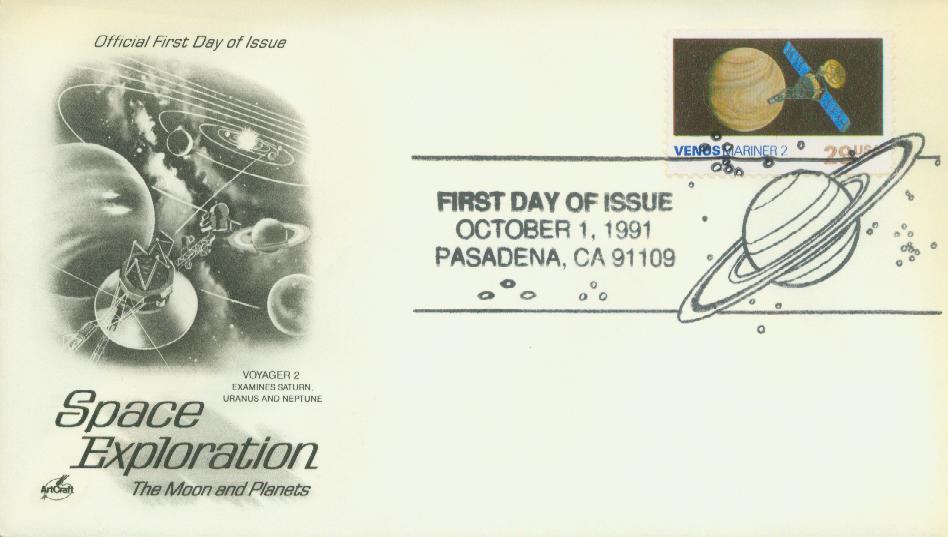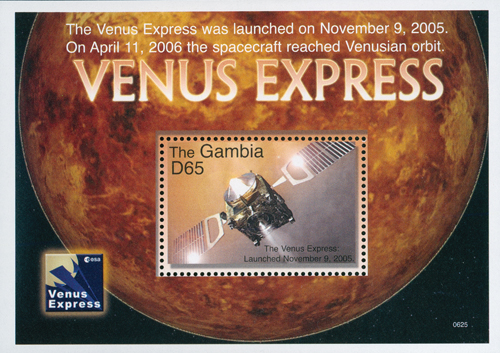
# 1557 - 1975 10c Mariner 10
1975 10¢ Mariner 10
City: Pasadena, California
Quantity: 158,600,000
Mariner 2 Flies By Venus
Identical to Mariner 1, which had launched a month earlier, Mariner 2 launched from Cape Canaveral, Florida on August 27, 1962. On its journey to Venus, Mariner 2 experienced some issues, but most were remotely correctable or were corrected by the probe itself.

On December 14, Mariner 2 became the first spacecraft to encounter another planet. On that day, 110 days into its mission, it passed within 21,607 miles of Venus. One of the most notable pieces of data from this flyby was the temperature. The temperature of Venus’ atmosphere was measured to be 900 degrees Fahrenheit.

Mariner 2 continued to travel beyond Venus and sent back its last transmission on January 3, 1963. The entire mission had lasted 129 days. Though it no longer sends back data, Mariner 2 is still in orbit today.
A great deal of information about Venus was revealed through the Mariner 2 mission. A microwave radiometer measured temperatures on different spots of the planet, revealing that its temperature is generally the same all around. An infrared radiometer confirmed that radiation temperatures were the same as measurements made from Earth.

Data from the magnetometer revealed Venus has a persistent interplanetary magnetic field. Another test showed that Venus didn’t have a detectable magnetosphere or radiation belt. Mariner 2 provided more accurate measurements of Venus’ mass and astronomical unit. And findings suggested that Venus rotates much slower than Earth and in the opposite direction. Future missions would confirm this.

Additional data collected throughout the journey showed seven small solar bursts of radiation. The probe also discovered in the space between planets, solar winds move continuously.

The next major mission to Venus occurred in 1970 when Venera 7 was the first to land a spacecraft on another planet. Finally, in the 1990s, the Magellan probe used radar to provide the first images of Venus’ surface. The photos revealed a planet covered with more than 1,000 volcanoes, some of which could still be active today.
Venus differs from Earth, and most of the planets, in that it rotates clockwise. Scientists speculate that Venus once spun in the same direction as Earth, but was struck by a large object, flipping the planet upside down, so it spins in the same direction but appears reversed.
Click here for more about Mariner 2.
1975 10¢ Mariner 10
City: Pasadena, California
Quantity: 158,600,000
Mariner 2 Flies By Venus
Identical to Mariner 1, which had launched a month earlier, Mariner 2 launched from Cape Canaveral, Florida on August 27, 1962. On its journey to Venus, Mariner 2 experienced some issues, but most were remotely correctable or were corrected by the probe itself.

On December 14, Mariner 2 became the first spacecraft to encounter another planet. On that day, 110 days into its mission, it passed within 21,607 miles of Venus. One of the most notable pieces of data from this flyby was the temperature. The temperature of Venus’ atmosphere was measured to be 900 degrees Fahrenheit.

Mariner 2 continued to travel beyond Venus and sent back its last transmission on January 3, 1963. The entire mission had lasted 129 days. Though it no longer sends back data, Mariner 2 is still in orbit today.
A great deal of information about Venus was revealed through the Mariner 2 mission. A microwave radiometer measured temperatures on different spots of the planet, revealing that its temperature is generally the same all around. An infrared radiometer confirmed that radiation temperatures were the same as measurements made from Earth.

Data from the magnetometer revealed Venus has a persistent interplanetary magnetic field. Another test showed that Venus didn’t have a detectable magnetosphere or radiation belt. Mariner 2 provided more accurate measurements of Venus’ mass and astronomical unit. And findings suggested that Venus rotates much slower than Earth and in the opposite direction. Future missions would confirm this.

Additional data collected throughout the journey showed seven small solar bursts of radiation. The probe also discovered in the space between planets, solar winds move continuously.

The next major mission to Venus occurred in 1970 when Venera 7 was the first to land a spacecraft on another planet. Finally, in the 1990s, the Magellan probe used radar to provide the first images of Venus’ surface. The photos revealed a planet covered with more than 1,000 volcanoes, some of which could still be active today.
Venus differs from Earth, and most of the planets, in that it rotates clockwise. Scientists speculate that Venus once spun in the same direction as Earth, but was struck by a large object, flipping the planet upside down, so it spins in the same direction but appears reversed.
Click here for more about Mariner 2.









